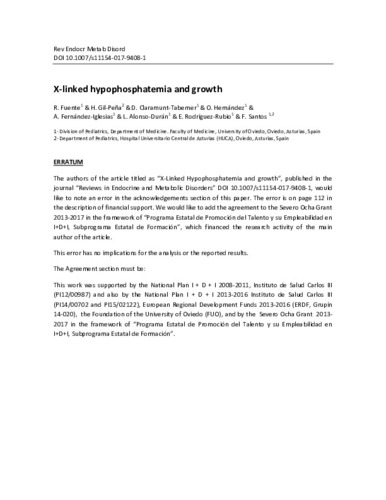X-linked hypophosphatemia and growth
Palabra(s) clave:
XLH
Growth
Fecha de publicación:
Editorial:
Springer US
Versión del editor:
Citación:
Descripción física:
Resumen:
X-Linked hypophosphatemia (XLH) is the most common form of hereditary rickets caused by loss-of function mutations in the PHEX gene. XLH is characterized by hypophosphatemia secondary to renal phosphate wasting, inappropriately low concentrations of 1,25 dihydroxyvitamin D and high circulating levels of fibroblast growth factor 23 (FGF23). Short stature and rachitic osseous lesions are characteristic phenotypic findings of XLH although the severity of these manifestations is highly variable among patients. The degree of growth impairment is not dependent on the magnitude of hypophosphatemia or the extent of legs´ bowing and height is not normalized by chronic administration of phosphate supplements and 1α hydroxyvitamin D derivatives. Treatment with growth hormone accelerates longitudinal growth rate but there is still controversy regarding the potential risk of increasing bone deformities and body disproportion. Treatments aimed at blocking FGF23 action are promising, but information is lacking on the consequences of counteracting FGF23 during the growing period. This review summarizes current knowledge on phosphorus metabolism in XLH, presents updated information on XLH and growth, including the effects of FGF23 on epiphyseal growth plate of the Hyp mouse, an animal model of the disease, and discusses growth hormone and novel FGF23 related therapies.
X-Linked hypophosphatemia (XLH) is the most common form of hereditary rickets caused by loss-of function mutations in the PHEX gene. XLH is characterized by hypophosphatemia secondary to renal phosphate wasting, inappropriately low concentrations of 1,25 dihydroxyvitamin D and high circulating levels of fibroblast growth factor 23 (FGF23). Short stature and rachitic osseous lesions are characteristic phenotypic findings of XLH although the severity of these manifestations is highly variable among patients. The degree of growth impairment is not dependent on the magnitude of hypophosphatemia or the extent of legs´ bowing and height is not normalized by chronic administration of phosphate supplements and 1α hydroxyvitamin D derivatives. Treatment with growth hormone accelerates longitudinal growth rate but there is still controversy regarding the potential risk of increasing bone deformities and body disproportion. Treatments aimed at blocking FGF23 action are promising, but information is lacking on the consequences of counteracting FGF23 during the growing period. This review summarizes current knowledge on phosphorus metabolism in XLH, presents updated information on XLH and growth, including the effects of FGF23 on epiphyseal growth plate of the Hyp mouse, an animal model of the disease, and discusses growth hormone and novel FGF23 related therapies.
Patrocinado por:
This work was supported by the National Plan I + D + I 2008-2011, Instituto de Salud Carlos III (PI12/00987) and also by the National Plan I + D + I 2013-2016 Instituto de Salud Carlos III (PI14/00702 and PI15/02122), European Regional Development Funds 2013-2016 (ERDF, Grupín 14-020), the Foundation of the University of Oviedo (FUO), and by the Severo Ocha Grant 2013-2017 in the framework of “Programa Estatal de Promoción del Talento y su Empleabilidad en I+D+I, Subprograma Estatal de Formación”
Colecciones
- Artículos [36923]
- Investigaciones y Documentos OpenAIRE [8186]
- Medicina [955]
Ficheros en el ítem





